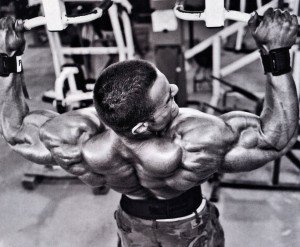>
When training the back, we must remember that the back muscles – are the largest and are designed for heavy workload throughout the day. So just need to train with large weights and train on the conscience! Argued that from heavy exercise increases waist, buttocks and lower back and buttock becomes wider than shoulders, but this is a complete nonsense. Of course, the waist is growing too, but with proper technique a spin grows much faster and your upper body becomes so massive that the waist seems even smaller, even is added another couple of centimeters.
Chin-up wide grip
These popular exercises have effects on muscles. At the same time “pump” your biceps and forearms. Chin-up “to the breast” develops a lower region of the broadest, but pulling “over head “- the upper region.
When performing chin-ups, make sure not to swing or jerk as momentum will make the exercise less efficient and promotes injury. During the chin-up, the lats, teres major, rear delt and traps contract to bring the arms down (or body up). The biceps contract to bend the elbow. The lats are the largest muscles of the upper body and the most powerful movers of the shoulder joint. Over developed lats muscles can have ahuge negative impact on the integrity of the shoulder and spinal joints. An easy way to check the flexibility of your lats is to stans with your arms hanging at your sides. If your hands naturally face inwards toward your body, you’re doing well. If your hands are more than slightly turned inwards and to the back of the room, your lats are too tight. Lay off the chins and simply hang from the bar for 30sec-1min to stretch out.
Traction barbell to the belt in inclination
This is one of the fundamental movements that promote active growth of the volume of the broadest muscles. Indirect burden placed on the muscles – extensors, trapezius(trap), biceps and forearm.
Technology of Implementation: stand next to the barbell and feet shoulder width apart grabbing it from the top. The legs bend at the knees. Bend so the body has acquired a right angle with legs. Arch spine and start to pull the barbell up until it touches the neck of the lower chest. Slowly lower the barbell to the starting position. To increase the amplitude of motion, we can stand on a small stand, or even on a small gymnastic bench.
One Arm Row
Assume a staggered stance and bend your knees. Bend forward at the waist supporting you body with one hand on your knee or a bench. Rows involve the biceps and mid-upper back including the Trapezius, Rhomboids and Posterior Deltoid (shoulder). During a row exercise; the biceps contract to bend the elbow; the posterior deltoid, teres major and latissimus dorsi (lats) contracts to bring the arm back; the rhomboids and trapezius (traps) contract to retract the shoulder blades; and the erector spine (lower back) contract to stabilize the spinal column. Rows are a great exercise for correcting slouched shoulders and winging of the scapula.
Pull the dumbbell up towards your body while retracting the shoulder blades. Keep your shoulders level as opposed to turning at the waist.
Bent over Row
Bend forward at the waist maintaining a neutral lower back and bent knees. Rows involve the biceps and mid-upper back including the Trapezius, Rhomboids and Posterior Deltoid (shoulder). During a row exercise; the biceps contract to bend the elbow; the posterior deltoid, teres major and latissimus dorsi (lats) contracts to bring the arm back; the rhomboids and trapezius (traps) contract to retract the shoulder blades; and the erector spinae (lower back) contract to stabilize the spinal column. Rows are a great exercise for correcting slouched shoulders and winging of the scapula.
Pull the dumbbells up towards your body while retracting the shoulder blades.
Traction to the chest through the upper block
Thrust loads to the chest muscles all the back from top to bottom. And besides, adds width and thickness of the outer edges of the broad – to be the “wings”.
Technology Implementation: In this activity you must use a wide grip. Sit down at an angle of 80 degrees to the floor. Drag the block to the level of the middle part of the chest, at the peak – a short pause, then controlled by the rise of the block.
Written by: Golden Muscles
© May 2010 www.goldenmuscles.com All rights reserved. Reprint article with link only.
Tags: Exercises for back
This entry was posted
on Wednesday, May 19th, 2010 at 9:06 am and is filed under TRAINING.
You can follow any responses to this entry through the RSS 2.0 feed.
You can leave a response, or trackback from your own site.

